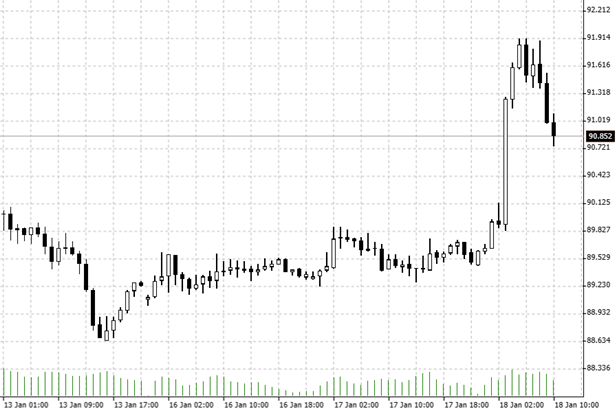

18.01.2023 – It was probably nothing: the market had hoped for a tightening by the Bank of Japan. But the Bank is stubborn. The yen is sliding against pretty much all currencies. And in the long run, the question is how this will continue.
Japan is maintaining its interest rate and yield curve policy. Thus, the key interest rate remains at – 0.1 per cent and the BoJ will continue to buy Japan bonds in the future without specifying a limit. This is to keep the yield at 0, it was said in Tokyo. The central bank had caused a surprise in December when it announced that the yield band for ten-year government bonds would be between minus and plus 0.5 per cent from now on. Previously, it had hovered at plus/minus 0.25 per cent. From which the forex market concluded that the yield may move upwards and that Tokyo must soon follow suit. Today’s statement took the wind out of these fantasies. Consequently, the yen slipped against the dollar, the euro, sterling, the New Zealand dollar and also against its Australian counterpart. Indeed, the reaction in the Aussie nicely illustrates the recent nervousness – investors had to put down a few more yen before profit-taking set in on AUDJPY – shown here in the hourly chart.

Source: Bernstein Bank GmbH
Japanese monetary policy is now causing quite a headache for some professionals. Phoenix Capital Research fears that “Japan’s central bank (…) is beginning to lose control of its financial system.” Since the introduction of quantitative easing in 1999, the central bank has never managed to normalise monetary policy. For more than twenty years, therefore, a nationalisation of the Japanese financial system has been taking place. The BoJ already holds about half of all Japanese government bonds issued and more equities than any other country or institution in the world. Bloomberg just added that in about 33 weeks there will be no more privately held Japan bonds left for Tokyo to buy.
Nationalisation of the financial market
The monetary guardians of Nippon are also the top 10 shareholder in 40 per cent of Japanese public companies, according to Phoenix. The central bank’s balance sheet amounts to 92 percent of Japan’s gross domestic product. We think: Lenin would be proud of the Japanese – they have implemented state socialism and nobody wants to notice. And red policies always end in disaster. But back to Phoenix Capital Research: Unfortunately, the bond market has started to test the BoJ’s resolve and yields have recently risen above the target range. This means that Tokyo has to intervene behind the scenes almost daily.
Plague or Cholera
Now the central bank is trapped, Phoenix added: if it continues to print yen to buy bonds and defend the yield target, the yen will collapse and inflation will explode. But if it stopped pumping air money into the market to hold bond yields, yields would shoot up and Japan would slide into insolvency. The investment house drew a parallel to 2008 – only this time an entire country would go bankrupt.
We add: If this scenario happens, a Japan crash will shake the entire financial world. Jim Grant, editor of “Grant’s Interest Rate Observer”, also fears that Japan could trigger a shock for the global financial system and advises buying gold. And so we wonder how long the current monetary policy should continue like this. The global analysis house Vanda Research also commented, “bond buying is nothing short of unsustainable”. According to the financial blog “ZeroHedge”, the BoJ has already spent the equivalent of 300 billion dollars on bond purchases this month alone. So keep an eye on the real-time news, it smells like intervention in the yen – or a break in current policy. Bernstein Bank wishes you successful trades and investments!
__________________________________________________________________________________________
The content of this publication is for general information purposes only. In this context, it is neither an individual investment recommendation or advice nor an offer to purchase or sell securities or other financial products. The content in question and all the information contained therein do not in any way replace individual investor- or investment-oriented advice. No reliable forecast or indication for the future is possible with respect to any presentation or information on the present or past performance of the relevant underlying assets. All information and data presented in this publication are based on reliable sources. However, Bernstein Bank does not guarantee that the information and data contained in this publication is up-to-date, correct and complete. Securities traded on the financial markets are subject to price fluctuations. A contract for difference (CFD) is also a financial instrument with leverage effect. Against this backdrop, CFD trading involves a high risk up to the point of total loss and may not be suitable for all investors. Therefore, make sure that you have fully understood all the correlating risks. If necessary, ask for independent advice. CFDs are complex instruments and are associated with the high risk of losing money quickly because of the leverage effect. 68% of retail investor accounts lose money trading CFD with this provider. You should consider whether you understand how CFD work and whether you can afford to take the high risk of losing your money.7
